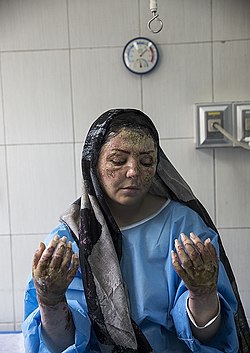acid attacks
An acid attack,also called acid throwing, vitriol attack, or vitriolage, is a form of violent assault involving the act of throwing acid or a similarly corrosive substance onto the body of another "with the intention to disfigure, maim, torture, or kill".[5] Perpetrators of these attacks throw corrosive liquids at their victims, usually at their faces, burning them, and damaging skin tissue, often exposing and sometimes dissolving the bones. Acid attacks can often lead to permanent blindness.
The most common types of acid used in these attacks are sulfuric and nitric acid. Hydrochloric acid is sometimes used, but is much less damaging.Aqueous solutions of strongly alkaline materials, such as caustic soda (sodium hydroxide), are used as well, particularly in areas where strong acids are controlled substances.
The long-term consequences of these attacks may include blindness, as well as eye burns, with severe permanent scarring of the face and body,along with far-reaching social, psychological, and economic difficulties.
Today, acid attacks are reported in many parts of the world, though more commonly in developing countries. Between 1999 and 2013, a total of 3,512 Bangladeshi people were attacked with acid with the rate of cases declining by 15%-20% every year since 2002 based on strict legislation against perpetrators and regulation of acid sales. In India, acid attacks are at an all-time high and increasing every year with 250-300 reported incidents every year while the "actual number could exceed 1,000, according to Acid Survivors' Trust International".
Although acid attacks occur all over the world, this type of violence is most common in South Asia. The UK has one of the highest rates of acid attacks per capita in the world, according to Acid Survivors Trust International (ASTI).In 2016, there were over 601 acid attacks in the UK based on ASTI figures, and 67% of the victims were male, but statistics from ASTI suggest that 80% of victims worldwide are women.Over 1,200 cases were recorded over the past five years. From 2011 to 2016, there were 1,464 crimes involving acid or corrosive substance in London alone.
Treatment and consequences
When acids contact the skin, response time is crucial. If washed away with water or neutralized promptly, burns to skin can be minimized or avoided entirely, although areas unprotected by skin, like the cornea of the eye or the lips, can be burned immediately on contact. However, many victims are attacked in an area without immediate access to water, or unable to see due to being blinded or forced to keep their eyes closed to prevent additional burns to the eye.
Treatment for burn victims remains inadequate in many developing nations where incidence is high. Medical underfunding has resulted in very few burn centers available for victims in countries such as Uganda,Bangladesh,and Cambodia.For example, Uganda has one specialized burn center in the entire nation, which opened in 2003; likewise, Cambodia has only one burn facility for victims,and scholars estimate that only 30% of the Bangladeshi community has access to health care.
In addition to inadequate medical capabilities, many acid assault victims fail to report to the police due to a lack of trust in the force, a sense of hopelessness due to the attackers' impunity, and a fear of male brutality in dealing with their cases. Most of the female victims suffer more because of police apathy in dealing with cases of harassment as safety issues as victims refused to register a police case despite being attacked thrice before meriting police aid after an acid attack.
These problems are exacerbated by a lack of knowledge of how to treat burns: many victims applied oil to the acid, rather than rinsing thoroughly and completely with water for 30 minutes or longer to neutralize the acid. Such home remedies only serve to increase the severity of damage, as they do not counteract the acidity.
"Stop over this acid attacks"
Thank youuuh...


Comments
Post a Comment